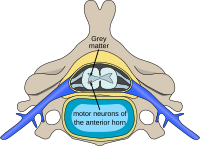Spinal muscular atrophies

Spinal muscular atrophies (SMA for short) is a big word that we use to describe a condition that affects how our muscles work.
Our muscles are like little machines that help us move around and stay strong. In SMA, there is a problem with some of the cells in our body that are responsible for making our muscles work properly. These cells are called motor neurons.
Motor neurons are like our body's messengers. They carry messages from our brains to our muscles, telling them what to do. When someone has SMA, their motor neurons don't work like they should, which means that the messages they send to our muscles don't get through properly.
Think of it like a message being sent from our brain to our muscles, but the delivery person (the motor neuron) gets lost along the way. Without this message, the muscles don't get told what to do and can start to shrink and weaken. This can make it hard for people with SMA to do things like walk or even breathe on their own.
There are different types of SMA, and some are more severe than others. Some children with SMA are born with it, while others may develop it later in life. There is no cure for SMA, but there are treatments that can help manage symptoms and improve quality of life. Physical therapy, respiratory support, and medications are some of the ways doctors can help people with SMA.
Our muscles are like little machines that help us move around and stay strong. In SMA, there is a problem with some of the cells in our body that are responsible for making our muscles work properly. These cells are called motor neurons.
Motor neurons are like our body's messengers. They carry messages from our brains to our muscles, telling them what to do. When someone has SMA, their motor neurons don't work like they should, which means that the messages they send to our muscles don't get through properly.
Think of it like a message being sent from our brain to our muscles, but the delivery person (the motor neuron) gets lost along the way. Without this message, the muscles don't get told what to do and can start to shrink and weaken. This can make it hard for people with SMA to do things like walk or even breathe on their own.
There are different types of SMA, and some are more severe than others. Some children with SMA are born with it, while others may develop it later in life. There is no cure for SMA, but there are treatments that can help manage symptoms and improve quality of life. Physical therapy, respiratory support, and medications are some of the ways doctors can help people with SMA.
Related topics others have asked about:
